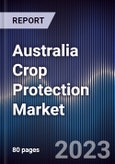The Australia Crop Protection Market segmentations include by origin, by type and by application; growth enablers and drivers; challenges and bottlenecks; trends driving adoption trends; regulatory framework; end-user analysis, industry analysis, competitive landscape including competition scenario and market shares of major players. The report concludes with future market projections of each market segmentation and analyst recommendations.
Market Overview:
According to publisher estimates, the Australia Crop Protection Market is forecasted to grow at a CAGR of ~% in the period of 2022-2027F, owing to the increase in demand for bio-pesticides and the adoption of herbicide-resistant crops by farmers.Crops, like wheat, barley, sugarcane, canola, cotton, vegetables, and fruits, are largely grown in Australia and are major users of pesticides.
While the prevalence of chemical or synthetic pesticides is expected to continue; human, animal, and environmental health concerns are expected to play key roles in driving the growth for bio-pesticides.
Key Trends by Market Segment:
- By Type: Herbicides accounted for the majority of the pesticide used in Australia, followed by insecticides, fungicides and other pesticides.Glyphosateis a herbicide which is widely used in Australia to control weeds. The Australian Pesticide and Veterinary Medicines Authority (APVMA) regulates the use of glyphosate
- By Application: Grains and Cereals segment dominates the market in terms of application. Among the major cereals grown in Australia include wheat, barley, oats, canary and triticale
Competitive Landscape
In Australia Crop Protection Market there are about ~ players operating in the overall market, and top ~ players accounted ~% share in the market in terms of revenue. The major parameters on which these players compete includes Year Established, Product Quality, Price and others.
Additional benefits of purchasing an enterprise license:
- TAM/SAM/SOM Analysis
- Customer Cohort Analysis
- Marketing Initiatives
- White Space Opportunity Analysis
- Interactive Data Visualizations
- Customization: 20 Analyst Hours
- 3 Months Post Sales Analyst Support
- Complimentary Update Next Year
- Custom Webinars
Table of Contents
Companies Mentioned (Partial List)
A selection of companies mentioned in this report includes, but is not limited to:
- Syngenta AG
- Bayer AG
- Corteva AgriScience
- BASF SE
- United Phosphorus Ltd
- ADAMA Agricultural Solutions
- FMC Corporation
- Nufarm Ltd
- Sumitomo Chemicals
- American Vanguard Corporation








